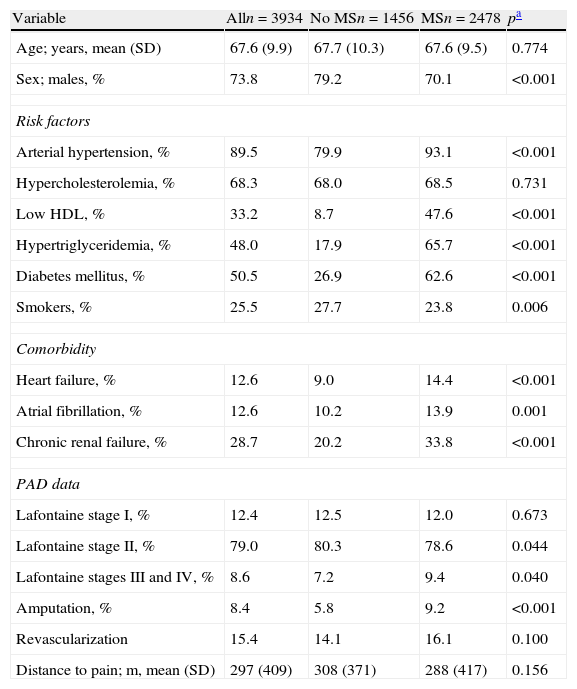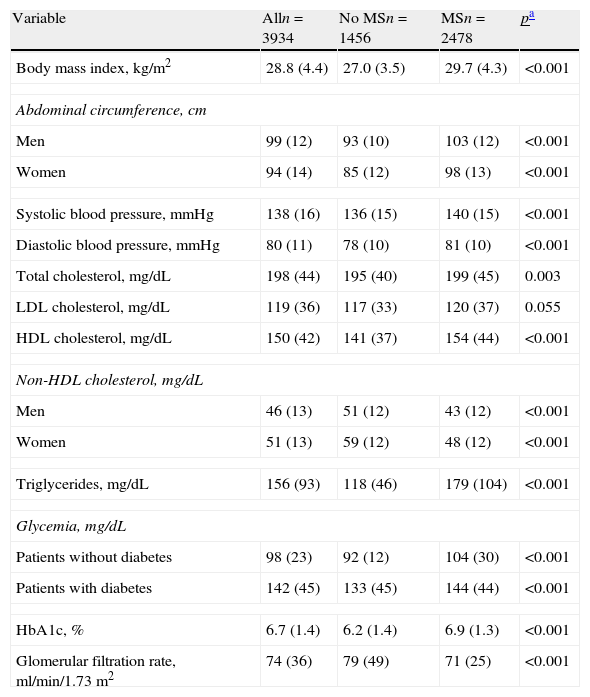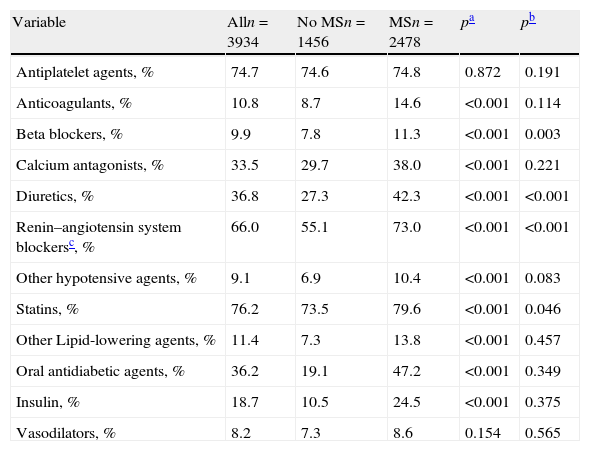The prevalence of metabolic syndrome (MS) in patients with peripheral arterial disease (PAD) and coronary or cerebrovascular disease is increasing, but it is not known whether this association also exists in patients with isolated PAD. The aim of the current study was to assess the prevalence of MS in patients with PAD who had no coronary or cerebrovascular disease, the prescription rate of evidence-based cardiovascular therapies and the attainment of therapeutic goals in patients with PAD and with and without MS.
Patients and methodsMulticenter, cross-sectional study of 3934 patients aged ≥45 years with isolated PAD who were treated in primary care and specialized outpatient clinics during 2009. A diagnosis of PAD was reached for ankle brachial indices <0.9, a previous history of amputation or revascularization.
ResultsIn the overall population, the mean age was 67.6 years, 73.8% were males and 63% had MS (95% CI, 61.5–64.3%). Patients with MS had a higher prevalence of cardiovascular risk factors and comorbidities, more severe PAD and higher prescription rate of evidence-based cardiovascular therapies. After adjusting for risk factors and comorbidity, there was a more frequent use of renin–angiotensin system blockers, beta-blockers, diuretics and statins among the patients with MS. A lower percentage of patients with MS achieved the therapeutic goals for blood pressure (22% vs. 41.5%, p<0.001). Similarly, a lower percentage of patients with diabetes achieved the glycated hemoglobin goals (44% vs. 53.1%, p<0.001), with no differences in LDL-cholesterol levels (29.8% vs. 39.1%, p=0.265).
ConclusionPatients with PAD have a high prevalence of MS. Patients with MS do not attain therapeutic goals as frequently as those without, despite taking more cardiovascular drugs.
La prevalencia del síndrome metabólico (SM) en pacientes con enfermedad arterial periférica (EAP) y arteriosclerosis de otros territorios está incrementada, pero se desconoce si también lo está en pacientes con EAP aislada. En pacientes con EAP, sin otra enfermedad aterosclerótica, hemos evaluado la prevalencia del SM y el grado de control de los factores de riesgo y fármacos cardiovasculares en comparación con enfermos sin SM.
Pacientes y métodosEstudio transversal multicéntrico, subestudio del PERIFÉRICA, realizado en consultas de atención primaria y especializada en 2009. Se incluyeron 3.934 pacientes, con ≥45 años y EAP documentada mediante el índice tobillo-brazo <0,9, amputación o revascularización arterial, sin antecedentes de enfermedad coronaria y/o cerebrovascular.
ResultadosLa edad media fue 67,6 años y el 73,8% eran varones. La prevalencia del SM fue del 63% (IC 95% 61,5–64,3%). Los pacientes con SM tenían mayor prevalencia de factores de riesgo, mayor comorbilidad, una EAP más grave y utilizaban más frecuentemente fármacos cardiovasculares. Tras ajustar por factores de riesgo y comorbilidad, los bloqueadores del sistema renina-angiotensina, betabloqueantes, diuréticos y estatinas eran los fármacos utilizados con mayor frecuencia. Los objetivos de presión arterial (22% vs. 41,5%, p<0,001) y de HbA1c en pacientes diabéticos (44% vs. 53,1%, p<0,001) se alcanzaron menos frecuentemente en los pacientes con SM que en los que no tenían esta condición, sin que hubiera diferencias en cuanto al colesterol-LDL (29,8% vs. 39,1%, p=0,265).
ConclusiónCerca de dos tercios de los pacientes con EAP padecen el SM. A pesar de utilizar más fármacos cardiovasculares los objetivos terapéuticos se alcanzan en una menor proporción que en los pacientes sin SM.
Article
Diríjase desde aquí a la web de la >>>FESEMI<<< e inicie sesión mediante el formulario que se encuentra en la barra superior, pulsando sobre el candado.

Una vez autentificado, en la misma web de FESEMI, en el menú superior, elija la opción deseada.

>>>FESEMI<<<










